London dispersion force - Study guides, Class notes & Summaries
Looking for the best study guides, study notes and summaries about London dispersion force? On this page you'll find 190 study documents about London dispersion force.
Page 4 out of 190 results
Sort by
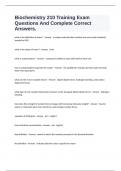
-
Biochemistry 210 Training Exam Questions And Complete Correct Answers.
- Exam (elaborations) • 2 pages • 2024
-
Available in package deal
-
- $8.99
- + learn more
what is the definition of water? - Answer a unique molecule that contains only non-metal covalently bonded as H2O what is the shape of water? - Answer bent what is autoionization? - Answer compound's ability to react with itself to form ions how is autoionization important for water? - Answer the equilibrium reaction permits water to break down into equal parts what are the 3 non-covalent forces? - Answer dipole-dipole forces, hydrogen bonding, and London dispersion forces...
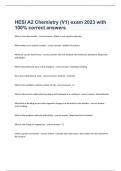
-
HESI A2 Chemistry (V1) exam 2023 with 100% correct answers
- Exam (elaborations) • 3 pages • 2023
-
Available in package deal
-
- $16.49
- + learn more
What is true about water - correct answer -Water is not a good conductor What makes up an atomic number - correct answer -number of protons What are van der Waal forces - correct answer -the two weakest intermolecular attractions (dispersion and dipole) Which intermolecular force is the strongest - correct answer -hydrogen bonding How do you find atomic mass - correct answer -protons + neutrons What is the oxidation reaction number of Mg - correct answer -+2 What is the process...
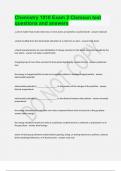
-
Chemistry 1010 Exam 2 Clemson test questions and answers
- Exam (elaborations) • 7 pages • 2024
-
- $13.49
- + learn more
a unit of matter that results when two or more atoms are joined by covalent bonds molecule a bond resulting from the electrostatic attraction of a cation for an anion ionic bond Brainpower Read More Previous Play Next Rewind 10 seconds Move forward 10 seconds Unmute 0:03 / 0:15 Full screen a bond characterized by an even distribution of charge; electrons in the bonds are shared equally by the two atoms non polar covalent bond charged group of more than one k...
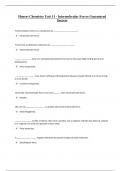
-
Honors Chemistry Unit 11 - Intermolecular Forces Guaranteed Success
- Exam (elaborations) • 5 pages • 2024
-
Available in package deal
-
- $9.89
- + learn more
Honors Chemistry Unit 11 - Intermolecular Forces Guaranteed Success Forces between atoms in a compound are _______________ ______. ️ Intramolecular forces. Forces that act between molecules are _______________ ______. ️ Intermolecular forces. _____ _________ have very strong bonds (attractive forces) so they have high melting points and boiling points. ️ Ionic compounds. ________ _________ have lower melting and boiling points because covalent bonds are not as stron...
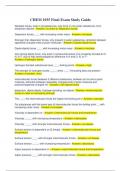
-
CHEM 1035 Final Exam Study Guide
- Exam (elaborations) • 14 pages • 2023
-
- $9.99
- + learn more
CHEM 1035 Final Exam Study Guide Weakest forces, exist in all substances, only force in non-polar substances, form temporary dipoles - Answer<>London or Dispersion forces Dispersion forces ____ with increasing molar mass - Answer<>increase Stronger than dispersion forces, only present in polar substances, attraction between oppositely charges ends of polar molecules - Answer<>Dipole-dipole forces Dipole-dipole forces ____ with increasing molar mass - Answer<>incre...
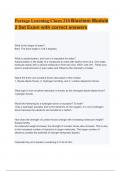
-
Portage Learning Chem 210 Biochem Module 2 Set Exam with correct answers
- Exam (elaborations) • 3 pages • 2024
- Available in package deal
-
- $7.99
- + learn more
What is the shape of water? Bent. The bond angle is 104.5 degrees. What is autoionization, and how is it important for water? Autoionization is the ability of a compound to react with itself to form ions. One water molecule reacts with a second molecule to form two ions: H3O+ and OH-. These ions exist in small amounts in pure water and influence the chemistry of water. Name the three non-covalent forces discussed in this module 1. Dipole-dipole forces, 2. Hydrogen bonding, and 3. London d...
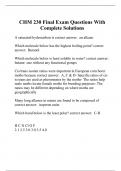
-
CHM 230 Final Exam Questions With Complete Solutions
- Exam (elaborations) • 9 pages • 2023
-
- $10.99
- + learn more
A saturated hydrocarbon is correct answer: an alkane Which molecule below has the highest boiling point? correct answer: Butanol Which molecule below is least soluble in water? correct answer: butane- one without any functional groups Cis/trans isomer ratios were important in European corn borer moths because correct answer: A, C & D- Specific ratios of cis to trans are used as pheromones by the moths- The ratios help male moths locate female moths for breeding purposes- The ratios ...
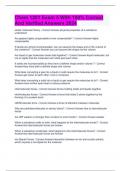
-
Chem 1201 Exam 5 With 100% Correct And Verified Answers 2024
- Exam (elaborations) • 4 pages • 2024
-
Available in package deal
-
- $11.49
- + learn more
Chem 1201 Exam 5 With 100% Correct And Verified Answers 2024 kinetic molecular theory - Correct Answer-physical properties of a substance understood Are gasses highly compressible or low compressible? - Correct Answer-highly compressible If liquids are almost incompressible, can you assume the shape and or the volume of the container? - Correct Answer-you can assume the shape not the volume Are liquid or gas molecules closer held together? - Correct Answer-liquid molecules, but not so ...
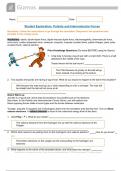
-
Gizmos Student Exploration Polarity and intermolecular Forces Questions with Correct Answers
- Exam (elaborations) • 4 pages • 2023
- Available in package deal
-
- $10.49
- + learn more
Directions: Follow the instructions to go through the simulation. Respond to the questions and prompts in the orange boxes. Vocabulary: dipole, dipole-dipole force, dipole-induced dipole force, electronegativity, intermolecular force, ionic bond, London dispersion force, molecule, nonpolar, nonpolar covalent bond, partial charges, polar, polar covalent bond, valence electron Prior Knowledge Questions (Do these BEFORE using the Gizmo.) 1. A big bully is having a tug-of-war with a small chil...
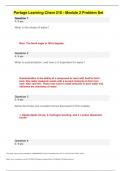
-
Portage Learning Chem 210 - Module 2 Problem Set
- Exam (elaborations) • 7 pages • 2023
-
Available in package deal
-
- $9.99
- + learn more
Portage Learning Chem 210 - Module 2 Problem Set What is the shape of water? Bent. The bond angle is 104.5 degrees. What is autoionization, and how is it important for water? Autoionization is the ability of a compound to react with itself to form ions. One water molecule reacts with a second molecule to form two ions: H3O+ and OH-. These ions exist in small amounts in pure water and influence the chemistry of water. Name the three non-covalent forces ...

Study stress? For sellers on Stuvia, these are actually golden times. KA-CHING! Earn from your study resources too and start uploading now. Discover all about earning on Stuvia


